Report: Reflective Analysis of Tesco's Internal Business Environment
VerifiedAdded on 2023/01/16
|12
|2752
|97
Report
AI Summary
This report provides a reflective analysis of Tesco's internal business environment, utilizing Porter's value chain model to assess the company's strengths and weaknesses. The analysis begins with an introduction to the value chain concept and its application in business strategy, followed by an overview of Tesco as a British multinational retailer. The report then delves into the primary and support activities within Tesco's value chain, examining areas such as inbound logistics, operations, marketing, and service, alongside infrastructure, HRM, technology development, and procurement. The study identifies key internal factors, including Tesco's strong supply chain management and online/offline presence as strengths, while highlighting its dependence on the UK/EU and financial errors as weaknesses. Finally, the report reflects on the value chain model's usefulness, emphasizing its role in identifying competitive advantages, interrelationships, and improved material flows, ultimately aiding Tesco in achieving its goals and enhancing its brand image. The report concludes by summarizing the benefits of continuous evaluation of the value chain for Tesco's productivity and cost comparisons with competitors.
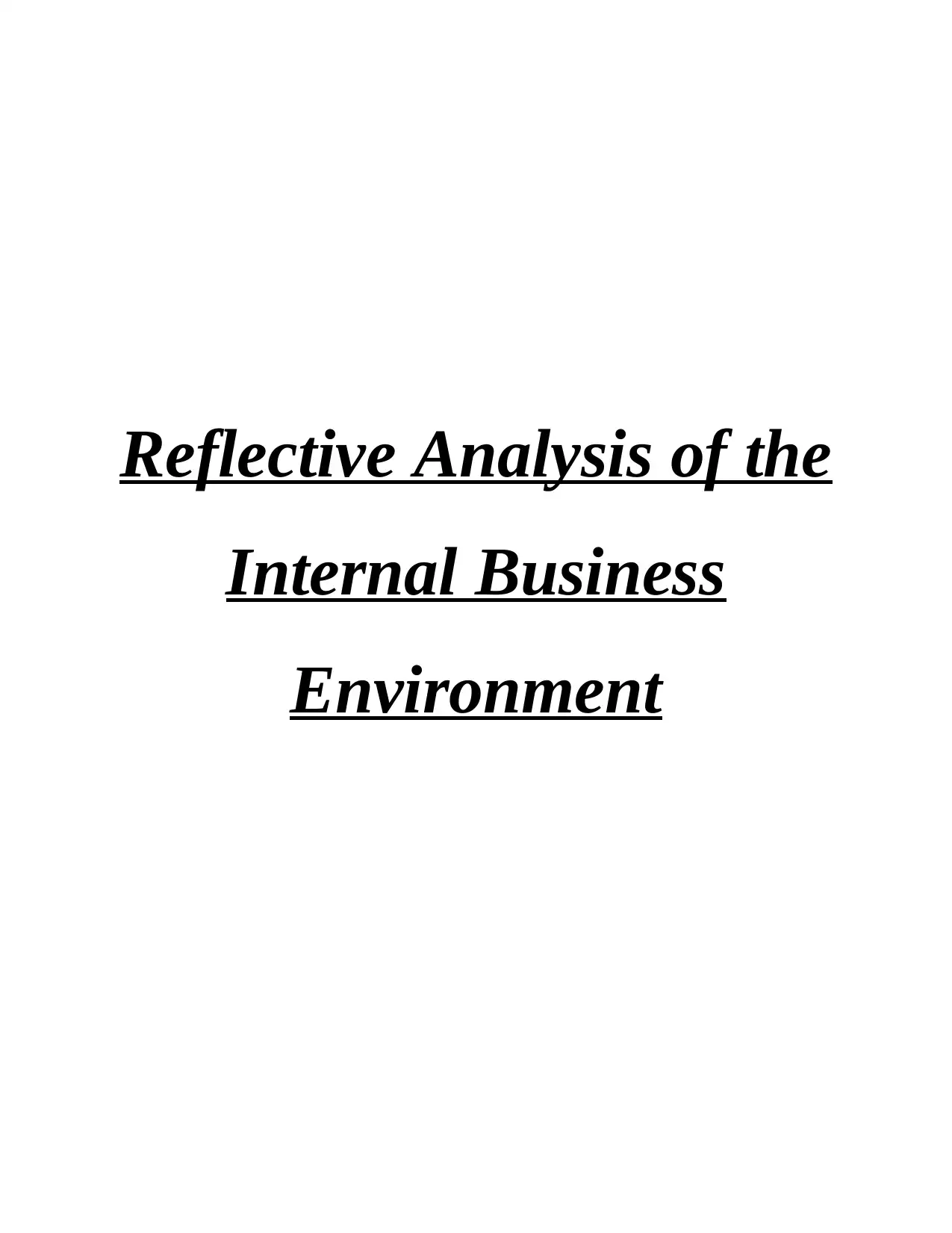
Reflective Analysis of the
Internal Business
Environment
Internal Business
Environment
Paraphrase This Document
Need a fresh take? Get an instant paraphrase of this document with our AI Paraphraser
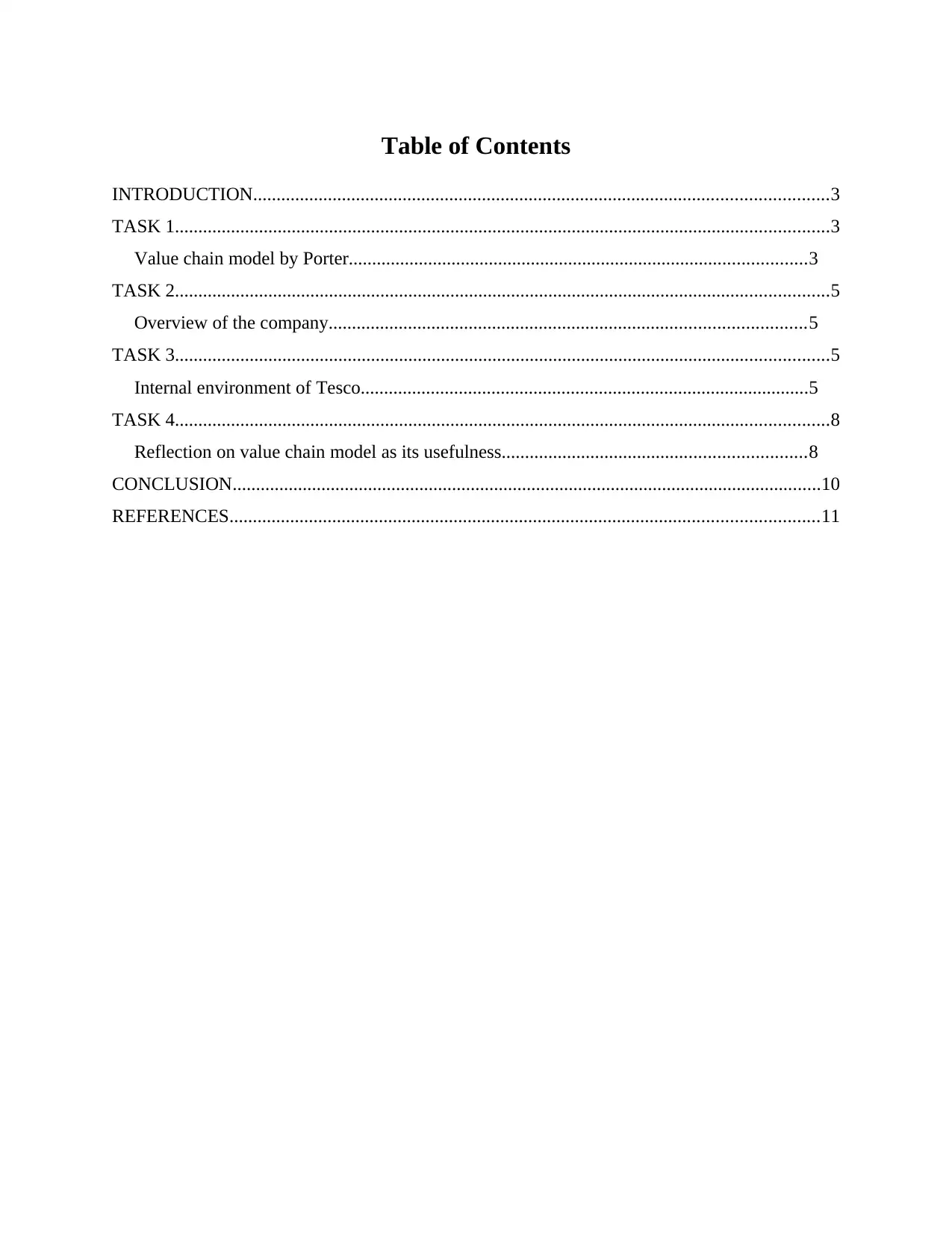
Table of Contents
INTRODUCTION...........................................................................................................................3
TASK 1............................................................................................................................................3
Value chain model by Porter..................................................................................................3
TASK 2............................................................................................................................................5
Overview of the company......................................................................................................5
TASK 3............................................................................................................................................5
Internal environment of Tesco................................................................................................5
TASK 4............................................................................................................................................8
Reflection on value chain model as its usefulness.................................................................8
CONCLUSION..............................................................................................................................10
REFERENCES..............................................................................................................................11
INTRODUCTION...........................................................................................................................3
TASK 1............................................................................................................................................3
Value chain model by Porter..................................................................................................3
TASK 2............................................................................................................................................5
Overview of the company......................................................................................................5
TASK 3............................................................................................................................................5
Internal environment of Tesco................................................................................................5
TASK 4............................................................................................................................................8
Reflection on value chain model as its usefulness.................................................................8
CONCLUSION..............................................................................................................................10
REFERENCES..............................................................................................................................11
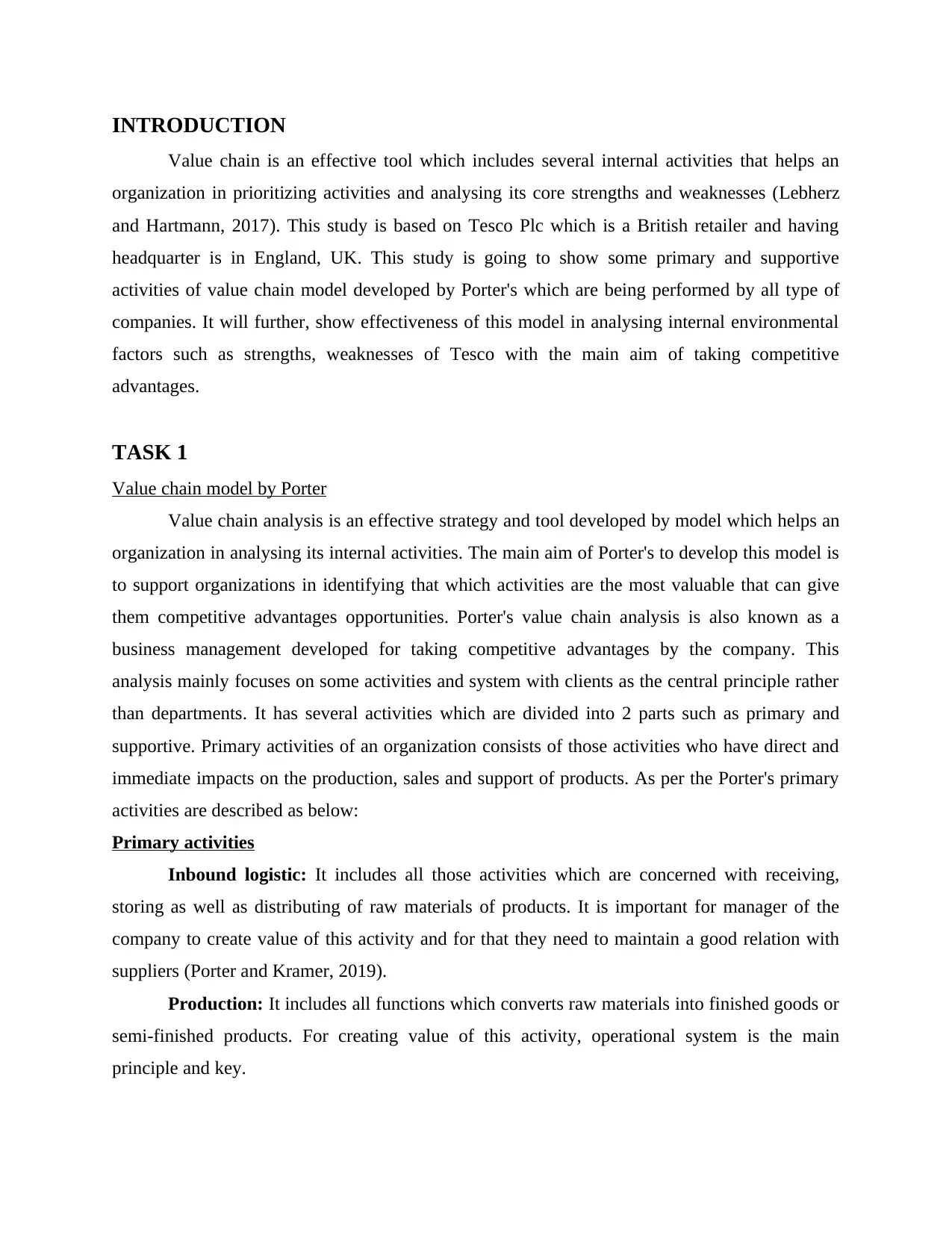
INTRODUCTION
Value chain is an effective tool which includes several internal activities that helps an
organization in prioritizing activities and analysing its core strengths and weaknesses (Lebherz
and Hartmann, 2017). This study is based on Tesco Plc which is a British retailer and having
headquarter is in England, UK. This study is going to show some primary and supportive
activities of value chain model developed by Porter's which are being performed by all type of
companies. It will further, show effectiveness of this model in analysing internal environmental
factors such as strengths, weaknesses of Tesco with the main aim of taking competitive
advantages.
TASK 1
Value chain model by Porter
Value chain analysis is an effective strategy and tool developed by model which helps an
organization in analysing its internal activities. The main aim of Porter's to develop this model is
to support organizations in identifying that which activities are the most valuable that can give
them competitive advantages opportunities. Porter's value chain analysis is also known as a
business management developed for taking competitive advantages by the company. This
analysis mainly focuses on some activities and system with clients as the central principle rather
than departments. It has several activities which are divided into 2 parts such as primary and
supportive. Primary activities of an organization consists of those activities who have direct and
immediate impacts on the production, sales and support of products. As per the Porter's primary
activities are described as below:
Primary activities
Inbound logistic: It includes all those activities which are concerned with receiving,
storing as well as distributing of raw materials of products. It is important for manager of the
company to create value of this activity and for that they need to maintain a good relation with
suppliers (Porter and Kramer, 2019).
Production: It includes all functions which converts raw materials into finished goods or
semi-finished products. For creating value of this activity, operational system is the main
principle and key.
Value chain is an effective tool which includes several internal activities that helps an
organization in prioritizing activities and analysing its core strengths and weaknesses (Lebherz
and Hartmann, 2017). This study is based on Tesco Plc which is a British retailer and having
headquarter is in England, UK. This study is going to show some primary and supportive
activities of value chain model developed by Porter's which are being performed by all type of
companies. It will further, show effectiveness of this model in analysing internal environmental
factors such as strengths, weaknesses of Tesco with the main aim of taking competitive
advantages.
TASK 1
Value chain model by Porter
Value chain analysis is an effective strategy and tool developed by model which helps an
organization in analysing its internal activities. The main aim of Porter's to develop this model is
to support organizations in identifying that which activities are the most valuable that can give
them competitive advantages opportunities. Porter's value chain analysis is also known as a
business management developed for taking competitive advantages by the company. This
analysis mainly focuses on some activities and system with clients as the central principle rather
than departments. It has several activities which are divided into 2 parts such as primary and
supportive. Primary activities of an organization consists of those activities who have direct and
immediate impacts on the production, sales and support of products. As per the Porter's primary
activities are described as below:
Primary activities
Inbound logistic: It includes all those activities which are concerned with receiving,
storing as well as distributing of raw materials of products. It is important for manager of the
company to create value of this activity and for that they need to maintain a good relation with
suppliers (Porter and Kramer, 2019).
Production: It includes all functions which converts raw materials into finished goods or
semi-finished products. For creating value of this activity, operational system is the main
principle and key.
⊘ This is a preview!⊘
Do you want full access?
Subscribe today to unlock all pages.

Trusted by 1+ million students worldwide
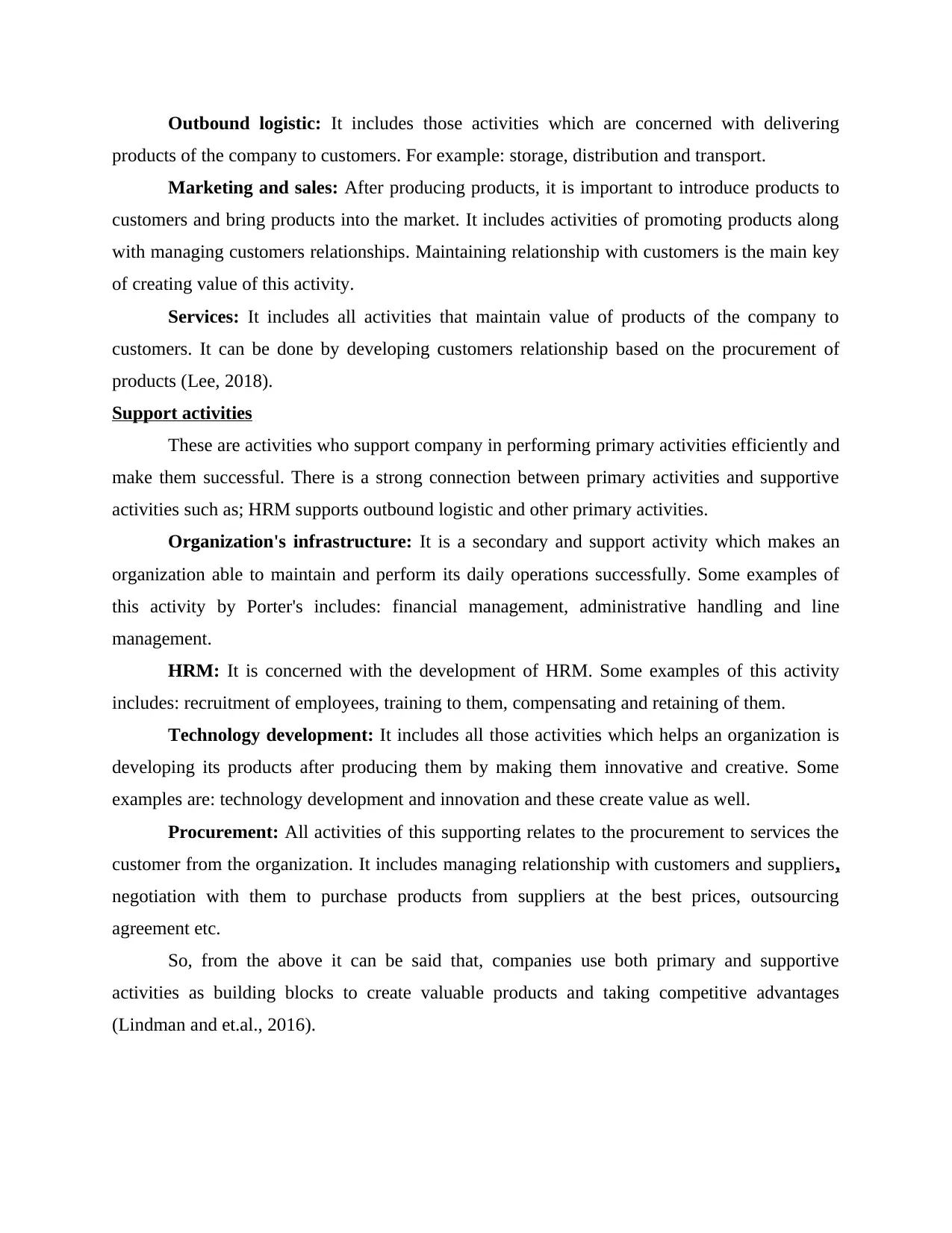
Outbound logistic: It includes those activities which are concerned with delivering
products of the company to customers. For example: storage, distribution and transport.
Marketing and sales: After producing products, it is important to introduce products to
customers and bring products into the market. It includes activities of promoting products along
with managing customers relationships. Maintaining relationship with customers is the main key
of creating value of this activity.
Services: It includes all activities that maintain value of products of the company to
customers. It can be done by developing customers relationship based on the procurement of
products (Lee, 2018).
Support activities
These are activities who support company in performing primary activities efficiently and
make them successful. There is a strong connection between primary activities and supportive
activities such as; HRM supports outbound logistic and other primary activities.
Organization's infrastructure: It is a secondary and support activity which makes an
organization able to maintain and perform its daily operations successfully. Some examples of
this activity by Porter's includes: financial management, administrative handling and line
management.
HRM: It is concerned with the development of HRM. Some examples of this activity
includes: recruitment of employees, training to them, compensating and retaining of them.
Technology development: It includes all those activities which helps an organization is
developing its products after producing them by making them innovative and creative. Some
examples are: technology development and innovation and these create value as well.
Procurement: All activities of this supporting relates to the procurement to services the
customer from the organization. It includes managing relationship with customers and suppliers,
negotiation with them to purchase products from suppliers at the best prices, outsourcing
agreement etc.
So, from the above it can be said that, companies use both primary and supportive
activities as building blocks to create valuable products and taking competitive advantages
(Lindman and et.al., 2016).
products of the company to customers. For example: storage, distribution and transport.
Marketing and sales: After producing products, it is important to introduce products to
customers and bring products into the market. It includes activities of promoting products along
with managing customers relationships. Maintaining relationship with customers is the main key
of creating value of this activity.
Services: It includes all activities that maintain value of products of the company to
customers. It can be done by developing customers relationship based on the procurement of
products (Lee, 2018).
Support activities
These are activities who support company in performing primary activities efficiently and
make them successful. There is a strong connection between primary activities and supportive
activities such as; HRM supports outbound logistic and other primary activities.
Organization's infrastructure: It is a secondary and support activity which makes an
organization able to maintain and perform its daily operations successfully. Some examples of
this activity by Porter's includes: financial management, administrative handling and line
management.
HRM: It is concerned with the development of HRM. Some examples of this activity
includes: recruitment of employees, training to them, compensating and retaining of them.
Technology development: It includes all those activities which helps an organization is
developing its products after producing them by making them innovative and creative. Some
examples are: technology development and innovation and these create value as well.
Procurement: All activities of this supporting relates to the procurement to services the
customer from the organization. It includes managing relationship with customers and suppliers,
negotiation with them to purchase products from suppliers at the best prices, outsourcing
agreement etc.
So, from the above it can be said that, companies use both primary and supportive
activities as building blocks to create valuable products and taking competitive advantages
(Lindman and et.al., 2016).
Paraphrase This Document
Need a fresh take? Get an instant paraphrase of this document with our AI Paraphraser
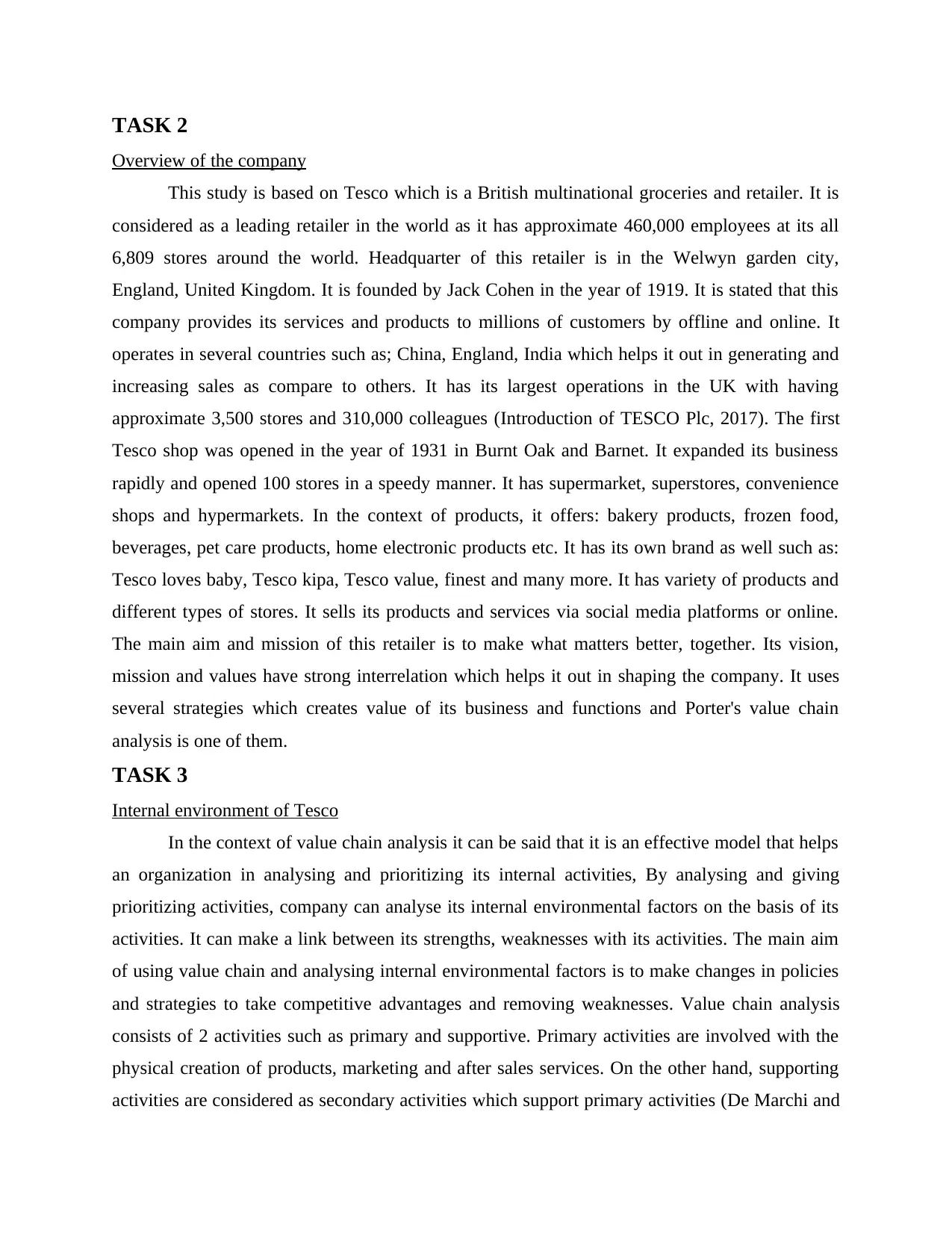
TASK 2
Overview of the company
This study is based on Tesco which is a British multinational groceries and retailer. It is
considered as a leading retailer in the world as it has approximate 460,000 employees at its all
6,809 stores around the world. Headquarter of this retailer is in the Welwyn garden city,
England, United Kingdom. It is founded by Jack Cohen in the year of 1919. It is stated that this
company provides its services and products to millions of customers by offline and online. It
operates in several countries such as; China, England, India which helps it out in generating and
increasing sales as compare to others. It has its largest operations in the UK with having
approximate 3,500 stores and 310,000 colleagues (Introduction of TESCO Plc, 2017). The first
Tesco shop was opened in the year of 1931 in Burnt Oak and Barnet. It expanded its business
rapidly and opened 100 stores in a speedy manner. It has supermarket, superstores, convenience
shops and hypermarkets. In the context of products, it offers: bakery products, frozen food,
beverages, pet care products, home electronic products etc. It has its own brand as well such as:
Tesco loves baby, Tesco kipa, Tesco value, finest and many more. It has variety of products and
different types of stores. It sells its products and services via social media platforms or online.
The main aim and mission of this retailer is to make what matters better, together. Its vision,
mission and values have strong interrelation which helps it out in shaping the company. It uses
several strategies which creates value of its business and functions and Porter's value chain
analysis is one of them.
TASK 3
Internal environment of Tesco
In the context of value chain analysis it can be said that it is an effective model that helps
an organization in analysing and prioritizing its internal activities, By analysing and giving
prioritizing activities, company can analyse its internal environmental factors on the basis of its
activities. It can make a link between its strengths, weaknesses with its activities. The main aim
of using value chain and analysing internal environmental factors is to make changes in policies
and strategies to take competitive advantages and removing weaknesses. Value chain analysis
consists of 2 activities such as primary and supportive. Primary activities are involved with the
physical creation of products, marketing and after sales services. On the other hand, supporting
activities are considered as secondary activities which support primary activities (De Marchi and
Overview of the company
This study is based on Tesco which is a British multinational groceries and retailer. It is
considered as a leading retailer in the world as it has approximate 460,000 employees at its all
6,809 stores around the world. Headquarter of this retailer is in the Welwyn garden city,
England, United Kingdom. It is founded by Jack Cohen in the year of 1919. It is stated that this
company provides its services and products to millions of customers by offline and online. It
operates in several countries such as; China, England, India which helps it out in generating and
increasing sales as compare to others. It has its largest operations in the UK with having
approximate 3,500 stores and 310,000 colleagues (Introduction of TESCO Plc, 2017). The first
Tesco shop was opened in the year of 1931 in Burnt Oak and Barnet. It expanded its business
rapidly and opened 100 stores in a speedy manner. It has supermarket, superstores, convenience
shops and hypermarkets. In the context of products, it offers: bakery products, frozen food,
beverages, pet care products, home electronic products etc. It has its own brand as well such as:
Tesco loves baby, Tesco kipa, Tesco value, finest and many more. It has variety of products and
different types of stores. It sells its products and services via social media platforms or online.
The main aim and mission of this retailer is to make what matters better, together. Its vision,
mission and values have strong interrelation which helps it out in shaping the company. It uses
several strategies which creates value of its business and functions and Porter's value chain
analysis is one of them.
TASK 3
Internal environment of Tesco
In the context of value chain analysis it can be said that it is an effective model that helps
an organization in analysing and prioritizing its internal activities, By analysing and giving
prioritizing activities, company can analyse its internal environmental factors on the basis of its
activities. It can make a link between its strengths, weaknesses with its activities. The main aim
of using value chain and analysing internal environmental factors is to make changes in policies
and strategies to take competitive advantages and removing weaknesses. Value chain analysis
consists of 2 activities such as primary and supportive. Primary activities are involved with the
physical creation of products, marketing and after sales services. On the other hand, supporting
activities are considered as secondary activities which support primary activities (De Marchi and
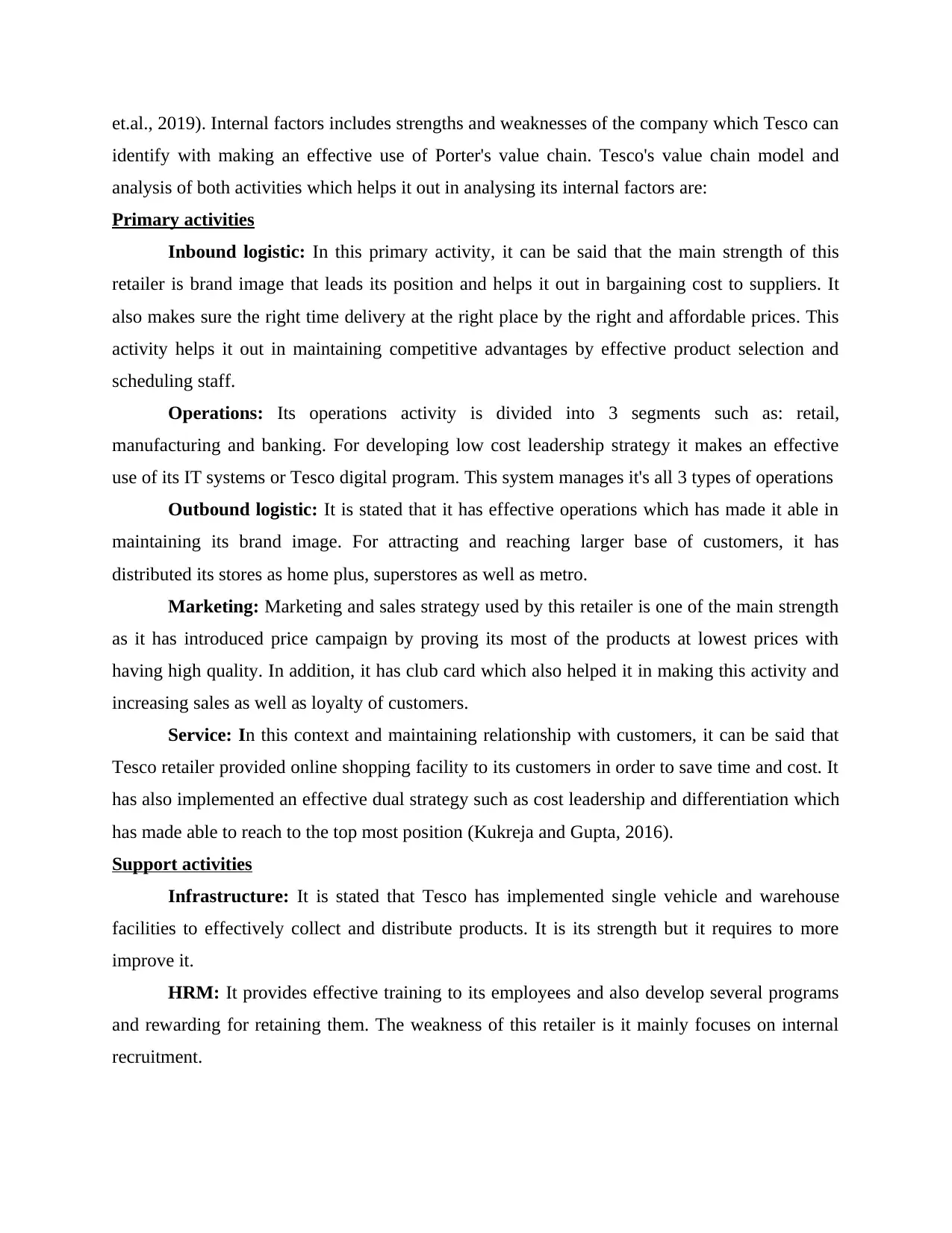
et.al., 2019). Internal factors includes strengths and weaknesses of the company which Tesco can
identify with making an effective use of Porter's value chain. Tesco's value chain model and
analysis of both activities which helps it out in analysing its internal factors are:
Primary activities
Inbound logistic: In this primary activity, it can be said that the main strength of this
retailer is brand image that leads its position and helps it out in bargaining cost to suppliers. It
also makes sure the right time delivery at the right place by the right and affordable prices. This
activity helps it out in maintaining competitive advantages by effective product selection and
scheduling staff.
Operations: Its operations activity is divided into 3 segments such as: retail,
manufacturing and banking. For developing low cost leadership strategy it makes an effective
use of its IT systems or Tesco digital program. This system manages it's all 3 types of operations
Outbound logistic: It is stated that it has effective operations which has made it able in
maintaining its brand image. For attracting and reaching larger base of customers, it has
distributed its stores as home plus, superstores as well as metro.
Marketing: Marketing and sales strategy used by this retailer is one of the main strength
as it has introduced price campaign by proving its most of the products at lowest prices with
having high quality. In addition, it has club card which also helped it in making this activity and
increasing sales as well as loyalty of customers.
Service: In this context and maintaining relationship with customers, it can be said that
Tesco retailer provided online shopping facility to its customers in order to save time and cost. It
has also implemented an effective dual strategy such as cost leadership and differentiation which
has made able to reach to the top most position (Kukreja and Gupta, 2016).
Support activities
Infrastructure: It is stated that Tesco has implemented single vehicle and warehouse
facilities to effectively collect and distribute products. It is its strength but it requires to more
improve it.
HRM: It provides effective training to its employees and also develop several programs
and rewarding for retaining them. The weakness of this retailer is it mainly focuses on internal
recruitment.
identify with making an effective use of Porter's value chain. Tesco's value chain model and
analysis of both activities which helps it out in analysing its internal factors are:
Primary activities
Inbound logistic: In this primary activity, it can be said that the main strength of this
retailer is brand image that leads its position and helps it out in bargaining cost to suppliers. It
also makes sure the right time delivery at the right place by the right and affordable prices. This
activity helps it out in maintaining competitive advantages by effective product selection and
scheduling staff.
Operations: Its operations activity is divided into 3 segments such as: retail,
manufacturing and banking. For developing low cost leadership strategy it makes an effective
use of its IT systems or Tesco digital program. This system manages it's all 3 types of operations
Outbound logistic: It is stated that it has effective operations which has made it able in
maintaining its brand image. For attracting and reaching larger base of customers, it has
distributed its stores as home plus, superstores as well as metro.
Marketing: Marketing and sales strategy used by this retailer is one of the main strength
as it has introduced price campaign by proving its most of the products at lowest prices with
having high quality. In addition, it has club card which also helped it in making this activity and
increasing sales as well as loyalty of customers.
Service: In this context and maintaining relationship with customers, it can be said that
Tesco retailer provided online shopping facility to its customers in order to save time and cost. It
has also implemented an effective dual strategy such as cost leadership and differentiation which
has made able to reach to the top most position (Kukreja and Gupta, 2016).
Support activities
Infrastructure: It is stated that Tesco has implemented single vehicle and warehouse
facilities to effectively collect and distribute products. It is its strength but it requires to more
improve it.
HRM: It provides effective training to its employees and also develop several programs
and rewarding for retaining them. The weakness of this retailer is it mainly focuses on internal
recruitment.
⊘ This is a preview!⊘
Do you want full access?
Subscribe today to unlock all pages.

Trusted by 1+ million students worldwide
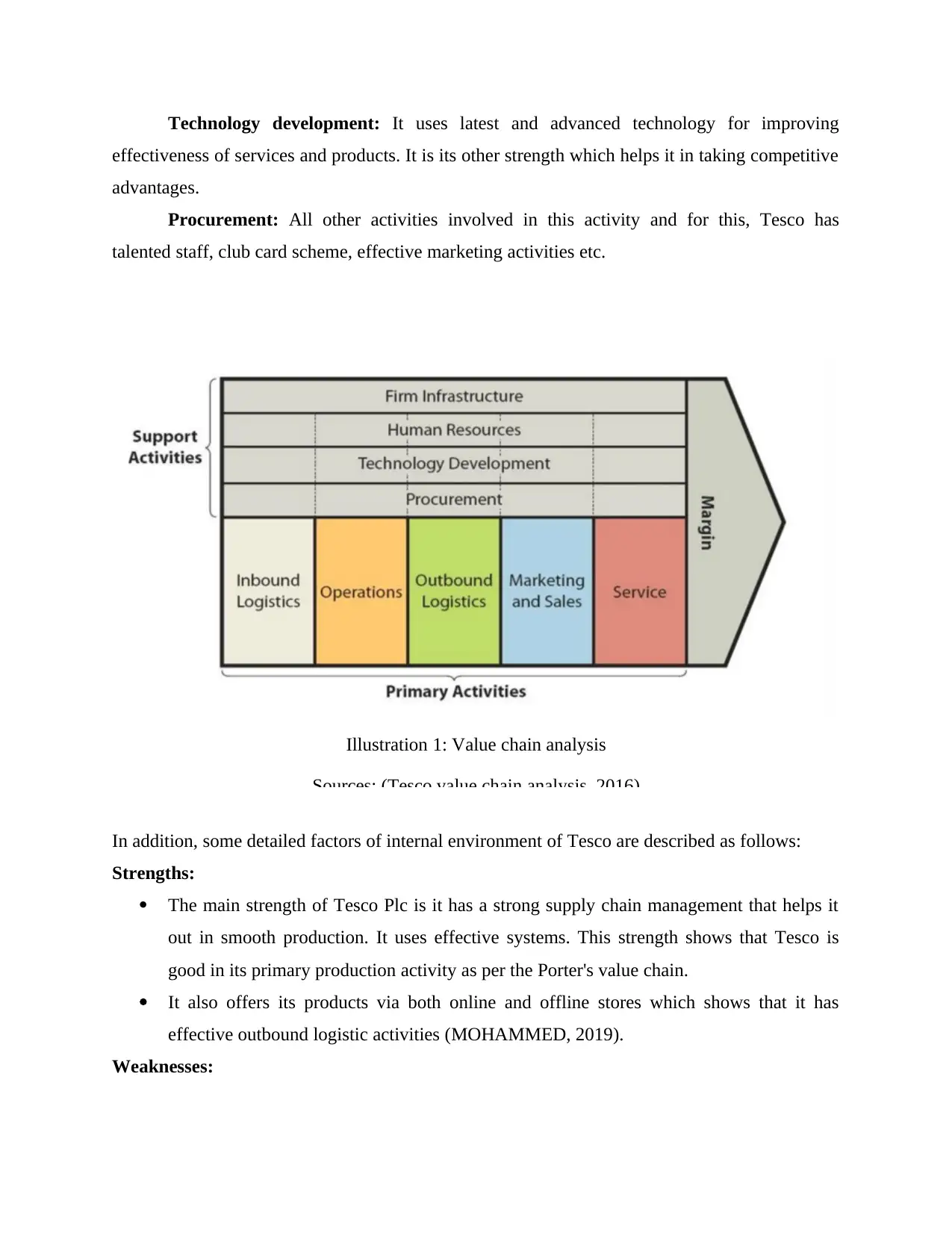
Technology development: It uses latest and advanced technology for improving
effectiveness of services and products. It is its other strength which helps it in taking competitive
advantages.
Procurement: All other activities involved in this activity and for this, Tesco has
talented staff, club card scheme, effective marketing activities etc.
In addition, some detailed factors of internal environment of Tesco are described as follows:
Strengths:
The main strength of Tesco Plc is it has a strong supply chain management that helps it
out in smooth production. It uses effective systems. This strength shows that Tesco is
good in its primary production activity as per the Porter's value chain.
It also offers its products via both online and offline stores which shows that it has
effective outbound logistic activities (MOHAMMED, 2019).
Weaknesses:
Illustration 1: Value chain analysis
Sources: (Tesco value chain analysis, 2016)
effectiveness of services and products. It is its other strength which helps it in taking competitive
advantages.
Procurement: All other activities involved in this activity and for this, Tesco has
talented staff, club card scheme, effective marketing activities etc.
In addition, some detailed factors of internal environment of Tesco are described as follows:
Strengths:
The main strength of Tesco Plc is it has a strong supply chain management that helps it
out in smooth production. It uses effective systems. This strength shows that Tesco is
good in its primary production activity as per the Porter's value chain.
It also offers its products via both online and offline stores which shows that it has
effective outbound logistic activities (MOHAMMED, 2019).
Weaknesses:
Illustration 1: Value chain analysis
Sources: (Tesco value chain analysis, 2016)
Paraphrase This Document
Need a fresh take? Get an instant paraphrase of this document with our AI Paraphraser
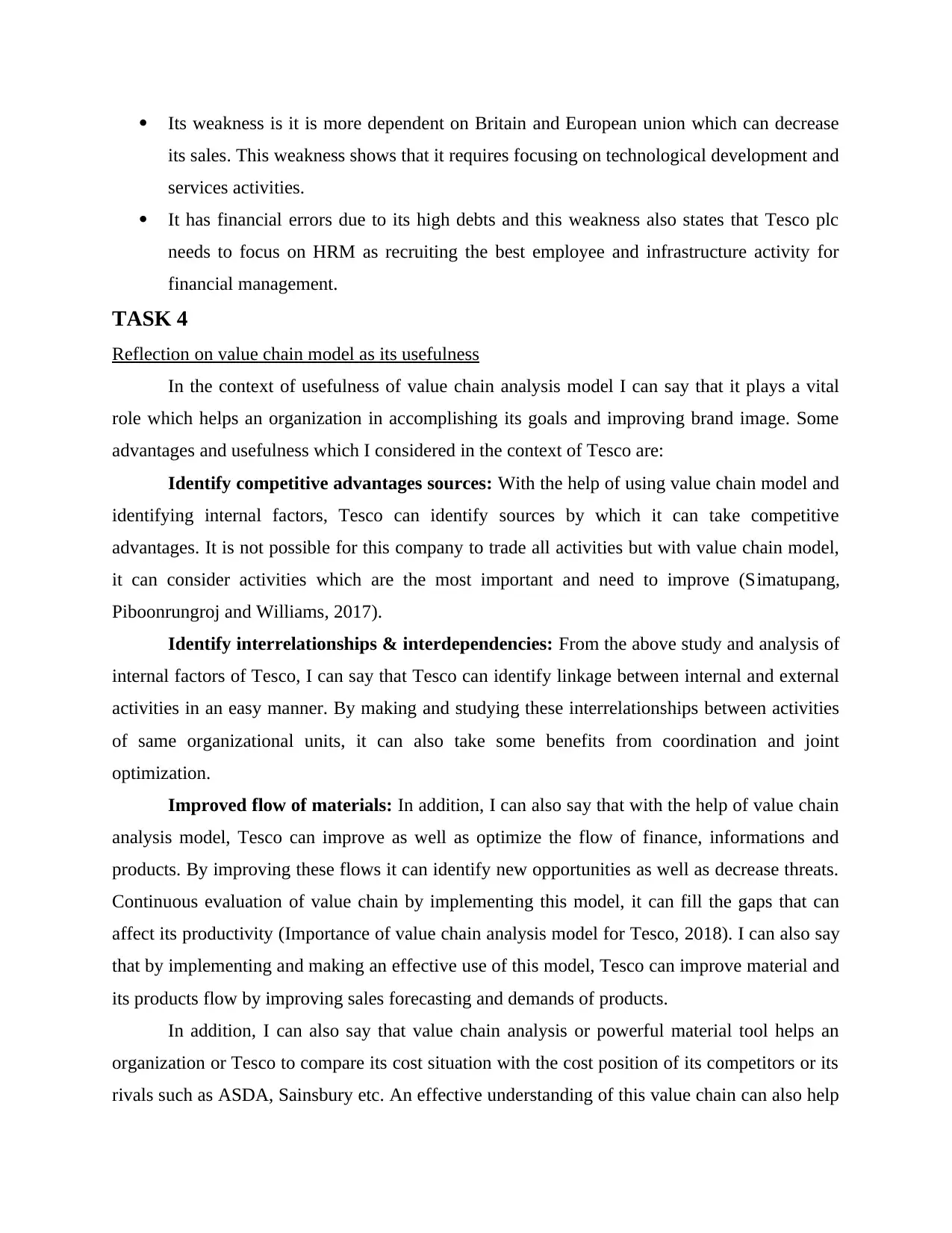
Its weakness is it is more dependent on Britain and European union which can decrease
its sales. This weakness shows that it requires focusing on technological development and
services activities.
It has financial errors due to its high debts and this weakness also states that Tesco plc
needs to focus on HRM as recruiting the best employee and infrastructure activity for
financial management.
TASK 4
Reflection on value chain model as its usefulness
In the context of usefulness of value chain analysis model I can say that it plays a vital
role which helps an organization in accomplishing its goals and improving brand image. Some
advantages and usefulness which I considered in the context of Tesco are:
Identify competitive advantages sources: With the help of using value chain model and
identifying internal factors, Tesco can identify sources by which it can take competitive
advantages. It is not possible for this company to trade all activities but with value chain model,
it can consider activities which are the most important and need to improve (Simatupang,
Piboonrungroj and Williams, 2017).
Identify interrelationships & interdependencies: From the above study and analysis of
internal factors of Tesco, I can say that Tesco can identify linkage between internal and external
activities in an easy manner. By making and studying these interrelationships between activities
of same organizational units, it can also take some benefits from coordination and joint
optimization.
Improved flow of materials: In addition, I can also say that with the help of value chain
analysis model, Tesco can improve as well as optimize the flow of finance, informations and
products. By improving these flows it can identify new opportunities as well as decrease threats.
Continuous evaluation of value chain by implementing this model, it can fill the gaps that can
affect its productivity (Importance of value chain analysis model for Tesco, 2018). I can also say
that by implementing and making an effective use of this model, Tesco can improve material and
its products flow by improving sales forecasting and demands of products.
In addition, I can also say that value chain analysis or powerful material tool helps an
organization or Tesco to compare its cost situation with the cost position of its competitors or its
rivals such as ASDA, Sainsbury etc. An effective understanding of this value chain can also help
its sales. This weakness shows that it requires focusing on technological development and
services activities.
It has financial errors due to its high debts and this weakness also states that Tesco plc
needs to focus on HRM as recruiting the best employee and infrastructure activity for
financial management.
TASK 4
Reflection on value chain model as its usefulness
In the context of usefulness of value chain analysis model I can say that it plays a vital
role which helps an organization in accomplishing its goals and improving brand image. Some
advantages and usefulness which I considered in the context of Tesco are:
Identify competitive advantages sources: With the help of using value chain model and
identifying internal factors, Tesco can identify sources by which it can take competitive
advantages. It is not possible for this company to trade all activities but with value chain model,
it can consider activities which are the most important and need to improve (Simatupang,
Piboonrungroj and Williams, 2017).
Identify interrelationships & interdependencies: From the above study and analysis of
internal factors of Tesco, I can say that Tesco can identify linkage between internal and external
activities in an easy manner. By making and studying these interrelationships between activities
of same organizational units, it can also take some benefits from coordination and joint
optimization.
Improved flow of materials: In addition, I can also say that with the help of value chain
analysis model, Tesco can improve as well as optimize the flow of finance, informations and
products. By improving these flows it can identify new opportunities as well as decrease threats.
Continuous evaluation of value chain by implementing this model, it can fill the gaps that can
affect its productivity (Importance of value chain analysis model for Tesco, 2018). I can also say
that by implementing and making an effective use of this model, Tesco can improve material and
its products flow by improving sales forecasting and demands of products.
In addition, I can also say that value chain analysis or powerful material tool helps an
organization or Tesco to compare its cost situation with the cost position of its competitors or its
rivals such as ASDA, Sainsbury etc. An effective understanding of this value chain can also help
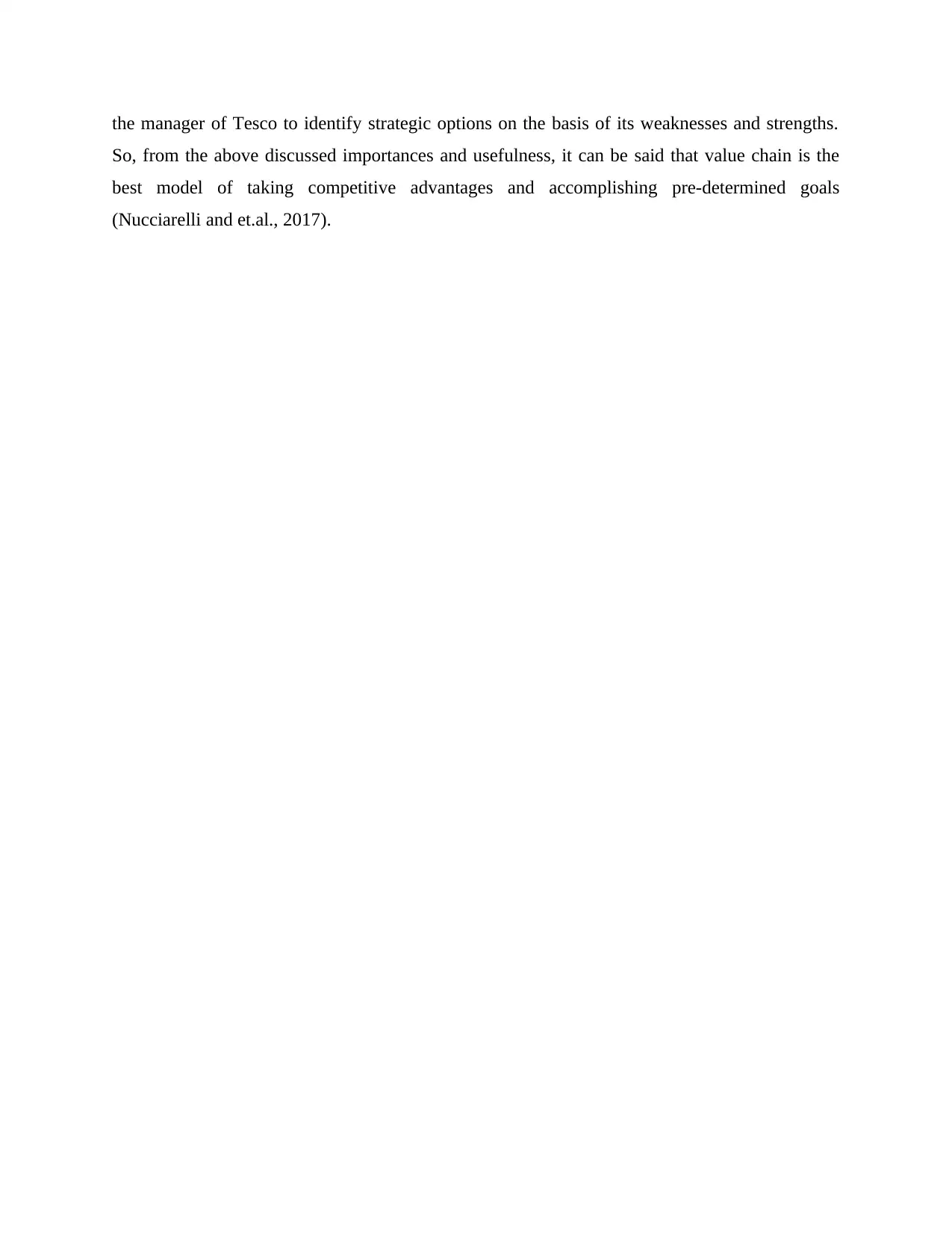
the manager of Tesco to identify strategic options on the basis of its weaknesses and strengths.
So, from the above discussed importances and usefulness, it can be said that value chain is the
best model of taking competitive advantages and accomplishing pre-determined goals
(Nucciarelli and et.al., 2017).
So, from the above discussed importances and usefulness, it can be said that value chain is the
best model of taking competitive advantages and accomplishing pre-determined goals
(Nucciarelli and et.al., 2017).
⊘ This is a preview!⊘
Do you want full access?
Subscribe today to unlock all pages.

Trusted by 1+ million students worldwide
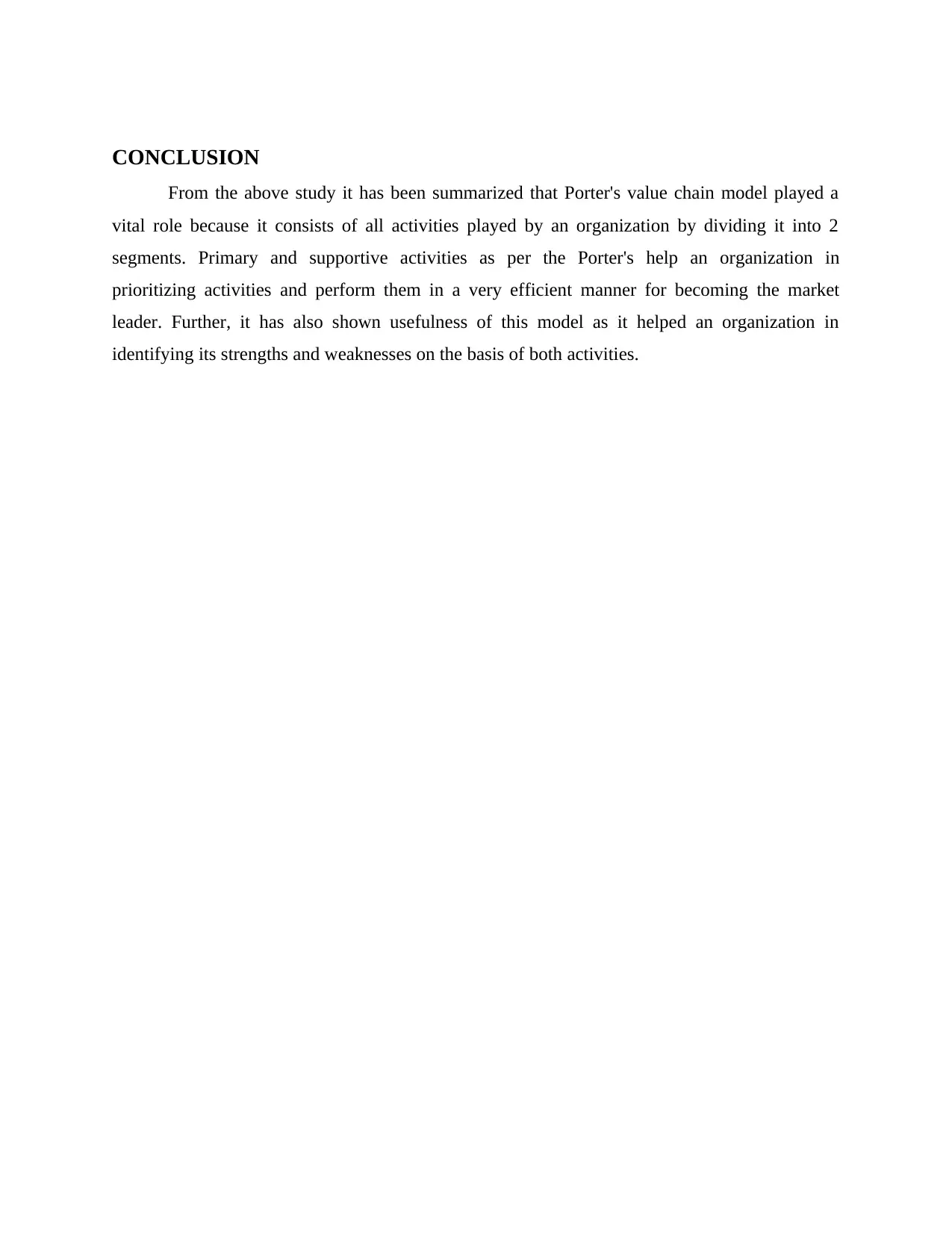
CONCLUSION
From the above study it has been summarized that Porter's value chain model played a
vital role because it consists of all activities played by an organization by dividing it into 2
segments. Primary and supportive activities as per the Porter's help an organization in
prioritizing activities and perform them in a very efficient manner for becoming the market
leader. Further, it has also shown usefulness of this model as it helped an organization in
identifying its strengths and weaknesses on the basis of both activities.
From the above study it has been summarized that Porter's value chain model played a
vital role because it consists of all activities played by an organization by dividing it into 2
segments. Primary and supportive activities as per the Porter's help an organization in
prioritizing activities and perform them in a very efficient manner for becoming the market
leader. Further, it has also shown usefulness of this model as it helped an organization in
identifying its strengths and weaknesses on the basis of both activities.
Paraphrase This Document
Need a fresh take? Get an instant paraphrase of this document with our AI Paraphraser
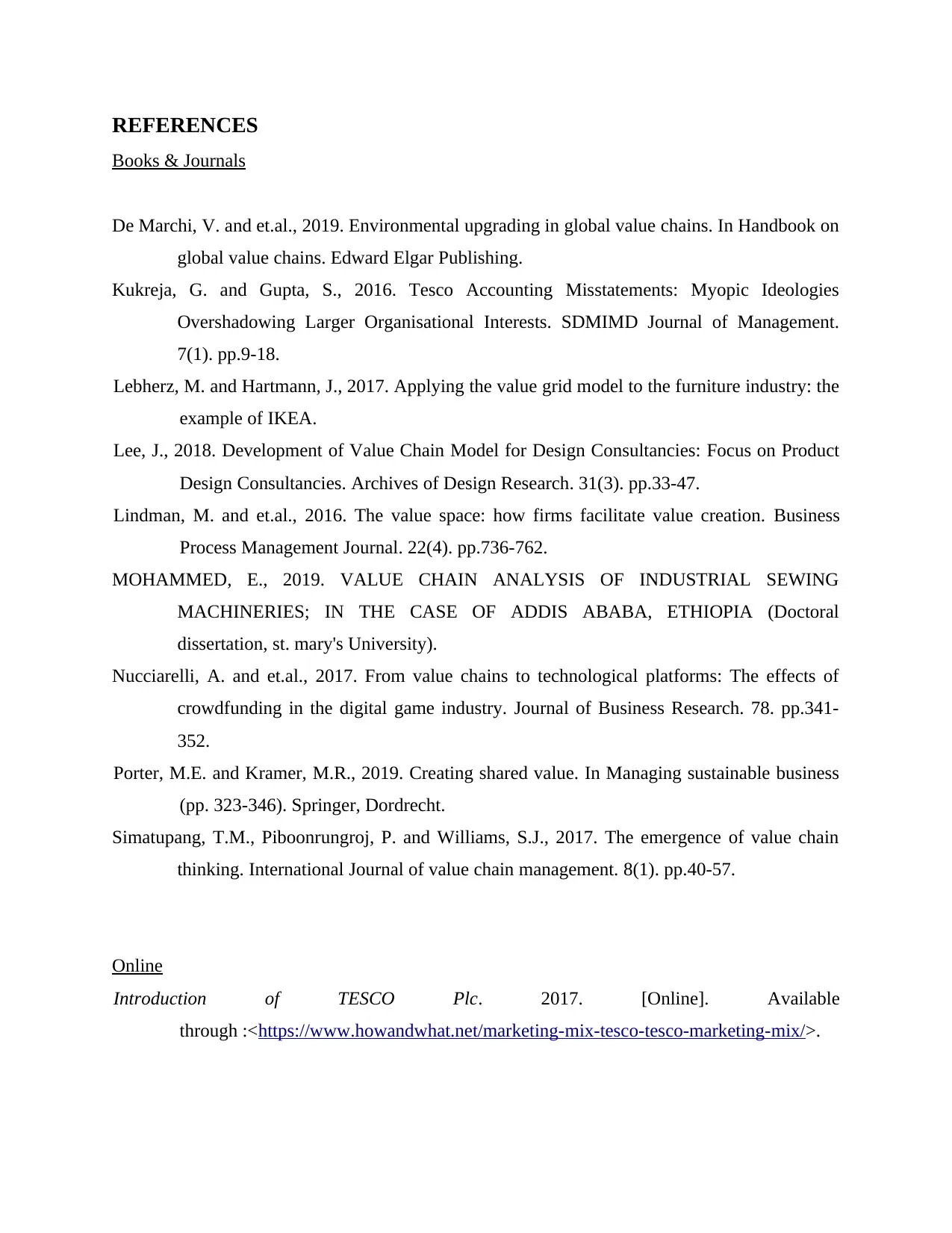
REFERENCES
Books & Journals
De Marchi, V. and et.al., 2019. Environmental upgrading in global value chains. In Handbook on
global value chains. Edward Elgar Publishing.
Kukreja, G. and Gupta, S., 2016. Tesco Accounting Misstatements: Myopic Ideologies
Overshadowing Larger Organisational Interests. SDMIMD Journal of Management.
7(1). pp.9-18.
Lebherz, M. and Hartmann, J., 2017. Applying the value grid model to the furniture industry: the
example of IKEA.
Lee, J., 2018. Development of Value Chain Model for Design Consultancies: Focus on Product
Design Consultancies. Archives of Design Research. 31(3). pp.33-47.
Lindman, M. and et.al., 2016. The value space: how firms facilitate value creation. Business
Process Management Journal. 22(4). pp.736-762.
MOHAMMED, E., 2019. VALUE CHAIN ANALYSIS OF INDUSTRIAL SEWING
MACHINERIES; IN THE CASE OF ADDIS ABABA, ETHIOPIA (Doctoral
dissertation, st. mary's University).
Nucciarelli, A. and et.al., 2017. From value chains to technological platforms: The effects of
crowdfunding in the digital game industry. Journal of Business Research. 78. pp.341-
352.
Porter, M.E. and Kramer, M.R., 2019. Creating shared value. In Managing sustainable business
(pp. 323-346). Springer, Dordrecht.
Simatupang, T.M., Piboonrungroj, P. and Williams, S.J., 2017. The emergence of value chain
thinking. International Journal of value chain management. 8(1). pp.40-57.
Online
Introduction of TESCO Plc. 2017. [Online]. Available
through :<https://www.howandwhat.net/marketing-mix-tesco-tesco-marketing-mix/>.
Books & Journals
De Marchi, V. and et.al., 2019. Environmental upgrading in global value chains. In Handbook on
global value chains. Edward Elgar Publishing.
Kukreja, G. and Gupta, S., 2016. Tesco Accounting Misstatements: Myopic Ideologies
Overshadowing Larger Organisational Interests. SDMIMD Journal of Management.
7(1). pp.9-18.
Lebherz, M. and Hartmann, J., 2017. Applying the value grid model to the furniture industry: the
example of IKEA.
Lee, J., 2018. Development of Value Chain Model for Design Consultancies: Focus on Product
Design Consultancies. Archives of Design Research. 31(3). pp.33-47.
Lindman, M. and et.al., 2016. The value space: how firms facilitate value creation. Business
Process Management Journal. 22(4). pp.736-762.
MOHAMMED, E., 2019. VALUE CHAIN ANALYSIS OF INDUSTRIAL SEWING
MACHINERIES; IN THE CASE OF ADDIS ABABA, ETHIOPIA (Doctoral
dissertation, st. mary's University).
Nucciarelli, A. and et.al., 2017. From value chains to technological platforms: The effects of
crowdfunding in the digital game industry. Journal of Business Research. 78. pp.341-
352.
Porter, M.E. and Kramer, M.R., 2019. Creating shared value. In Managing sustainable business
(pp. 323-346). Springer, Dordrecht.
Simatupang, T.M., Piboonrungroj, P. and Williams, S.J., 2017. The emergence of value chain
thinking. International Journal of value chain management. 8(1). pp.40-57.
Online
Introduction of TESCO Plc. 2017. [Online]. Available
through :<https://www.howandwhat.net/marketing-mix-tesco-tesco-marketing-mix/>.
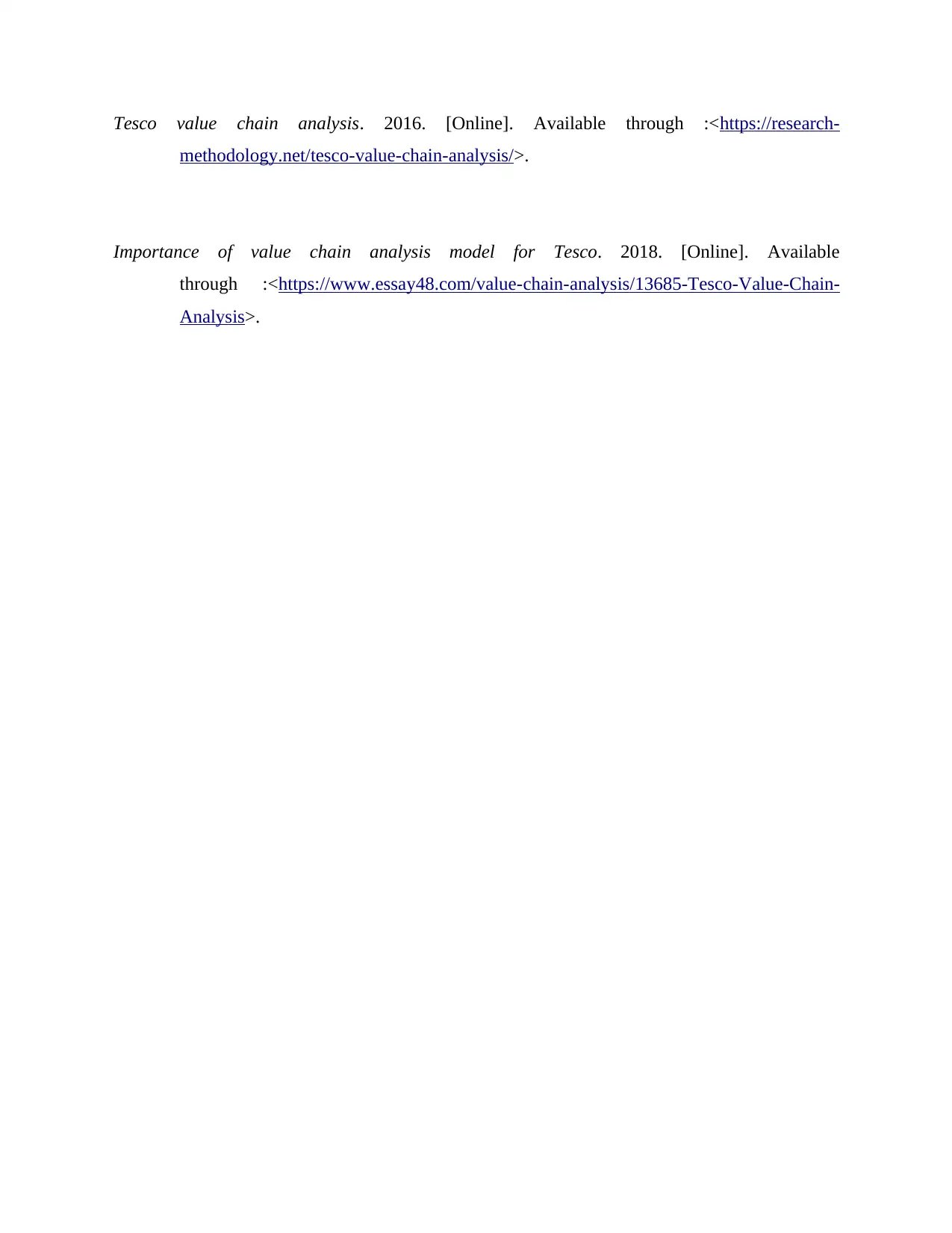
Tesco value chain analysis. 2016. [Online]. Available through :<https://research-
methodology.net/tesco-value-chain-analysis/>.
Importance of value chain analysis model for Tesco. 2018. [Online]. Available
through :<https://www.essay48.com/value-chain-analysis/13685-Tesco-Value-Chain-
Analysis>.
methodology.net/tesco-value-chain-analysis/>.
Importance of value chain analysis model for Tesco. 2018. [Online]. Available
through :<https://www.essay48.com/value-chain-analysis/13685-Tesco-Value-Chain-
Analysis>.
⊘ This is a preview!⊘
Do you want full access?
Subscribe today to unlock all pages.

Trusted by 1+ million students worldwide
1 out of 12
Related Documents
Your All-in-One AI-Powered Toolkit for Academic Success.
+13062052269
info@desklib.com
Available 24*7 on WhatsApp / Email
![[object Object]](/_next/static/media/star-bottom.7253800d.svg)
Unlock your academic potential
Copyright © 2020–2025 A2Z Services. All Rights Reserved. Developed and managed by ZUCOL.





